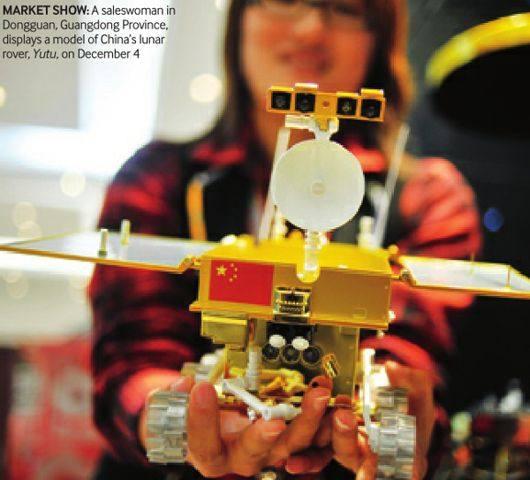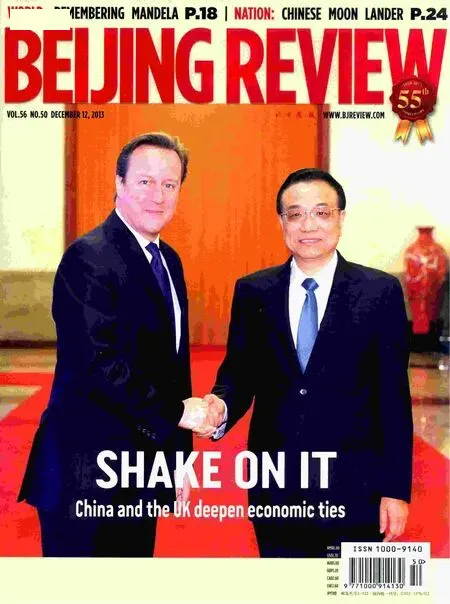Lunar Aspirations
By Yuan Yuan

After 10 years of space exploration efforts, China has finally launched its first mission to land a spacecraft on the surface of an extraterrestrial body.
On December 2, Chinas third lunar probe, Change-3, was launched into space on an enhanced Long March 3B rocket at the Xichang Satellite Launch Center in southwestern Sichuan Province. Change-3 is expected to soft land on the moon in mid-December, making it the first mission to do so since the former Soviet Unions Luna 24 mission in 1976.
Change-3 comprises a lander and a sixwheeled lunar rover equipped with four cameras and two mechanical legs that allow it to dig up soil samples. The rover, named Yutu, meaning Jade Rabbit, will survey the moons geological structure and surface substances during its three-month lifespan, while looking for natural resources. According to Chinese folklore, the goddess Change lives on the moon with only a white rabbit for companion.
“If successful, the Change-3 mission will give China the ability to explore the surface of an extraterrestrial body,” said Sun Huixian, deputy engineer in chief of the second phase of Chinas lunar program.
Milestone mission
“This will be a breakthrough for China in conducting observation and survey of the moons surface,” said Wu Weiren, chief designer of Chinas lunar program. “More than 80 percent of technologies and products used during the mission are newly developed.”
After entering lunar orbit, Change-3 will go through six stages of deceleration to descend from 15 km above to the lunar surface, Xinhua News Agency reported on November 29.
The soft landing processes used by U.S. and Soviet unmanned spacecraft in the 1970s were unable to hover or avoid obstacles. Change-3 can accurately survey its landing site and identify the safest spots on which to land, according to Sun.
In order to land quickly, the probe is equipped with high-precision, fast-response sensors that analyze its motion and surroundings. The variable thrust engine designed and made domestically by Chinese scientists and used for Change-3 can generate up to 7,500 newtons of thrust.
During the Chang-3 mission, a telescope will be set up on the moon, for the first time in human history, to observe the inner region of the Earths magnetosphere—the area where the planets magnetic field is still strong enough to affect charged particles in space. The lunar rover will also survey the moon surface using radar.
Change-3 is part of the second phase of Chinas lunar program, which includes orbiting, landing and returning to Earth.
In phase three, Chinas unmanned probe will return to Earth with lunar soil and rock samples. The timetable for this phase has not been specified, but earlier reports suggested that it could be concluded as early as 2020.
In June 2011, the Chinese Academy of Sciences released a development roadmap for the countrys scientific sector. It estimated that China will be able to accomplish a manned mission to the moon and set up a lunar base around 2030, with the base to be able to launch manned spacecraft from approximately 2050.
Achievements
The Chinese Government approved the lunar program in January 2004, three months after China sent its first astronaut into space, becoming the third country after Russia and the United States capable of launching an independent manned space travel mission.
Scientists said that Chinas space program has started later than other countries, so its own exploration missions must not follow the beaten path, but forge ahead with a new strategy and long-term design.
Change-3 follows the success of the Change-1 and Change-2 probes, launched on October 24, 2007 and October 1, 2010, respectively.
Change-1 transmitted back 1.37 terabytes of data, producing Chinas first complete imaging of the moon after orbiting it for 494 days. On November 12, 2008 China published the first lunar hologram with a resolution of 7 meters based on data collected by Change-1.
The probe hard landed on the lunar surface on March 1, 2009 opening up a new age of space exploration for China.
Change-2 tested some of the technology crucial to the Change-3 mission and preformed reconnaissance of the landing area to be used by Change-3, as well as taking what is potentially the highest resolution image of the lunar surface to date with a resolution of 7 meters.
Currently, Change-2 is more than 60 million km away from the Earth and has become Chinas first man-made asteroid. It is currently heading toward deep space and is expected to travel as far as 300 million km away from Earth, the longest voyage of any Chinese spacecraft.
Space exploration
“Everyone knows fossil fuels such as gas and coal will be used up one day, but there are at least 1 million metric tons of helium-3 on the moon,” said Ouyang Ziyuan, chief scientist of Chinas lunar program.
Helium-3 is considered by many scientists to be a nearly perfect energy source that could be used in nuclear fusion and has the potential to replace oil and gas, as it is non-polluting and has no radioactive byproducts. Helium-3 is very rare on Earth, but is believed to be more abundant on the moon.
“If mining the moon for helium-3 and obtaining nuclear power from it become reality, moon resources could be used to generate power for more than 10,000 years,” Ouyang said.
Luan Enjie, another senior adviser to Chinas lunar program, said that China ultimately aims to use the moon as a “springboard” for deep space exploration.
“Weve embarked in deep space exploration for 10 years, and we still have a long way to go,”said Luan, former Director of the China National Space Administration. “Many of our scientists are studying Mars, and how Chinese astronauts could land on it.”

